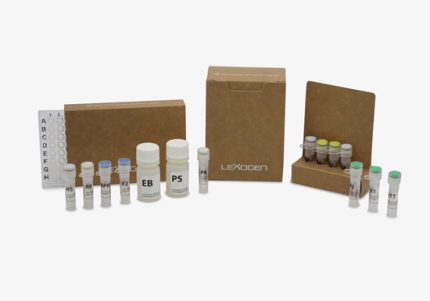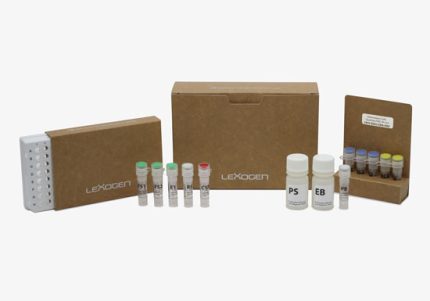Custom Bioinformatics Solutions
Login to see pricesWith decades of experience in transcriptomics, genomics, and related fields of biology, our bioinformatics team is empowered to tailor new bioinformatics developments to your unique project. We offer various Custom Bioinformatics Solutions, including new tool and pipeline developments, by using state-of-the-art algorithms and computational methods. With our personal and customized approach, we deliver most reliable and accurate outcomes enabling you to differentiate and drive innovation. Post-project, we provide detailed documentation and reporting, as well as secure and full transfer of custom pipeline.
Lexogen Bioinformatics Service
Login to see pricesNext-generation sequencing (NGS) technologies are invaluable in academic research, biotechnology, biomedical and clinical research, and the pharmaceutical industry. As NGS technologies rapidly expand and develop, it is imperative to correctly interpret increasingly complex data sets and relate them to biological functions. More than ever, it is necessary to approach NGS data analysis with tailored and creative data analysis workflows to extract the most from the datasets obtained.
Our team consists of genomic data analysis experts with experience in various NGS data analysis pipelines who are passionate about developing novel, customized workflows and solutions while keeping biology at the forefront.
We speak your language, so focus on your research and leave the data analysis to us.
DNA Sequencing
Login to see pricesNext-generation sequencing (NGS) technologies enable researchers to investigate the genetic basis of biological function, variation, and disease with increasing depth and throughput. Various DNA sequencing approaches are available to facilitate numerous applications, including variant discovery, genome assembly, resequencing, phylogenetics, genotyping, and taxon identification.
DNA sequencing services from Lexogen can start with DNA extraction or library preparation, with optional target enrichment. We use top-quality library generation methods with customized sequencing and data analysis approaches according to individual project requirements and target applications. DNA extraction can be performed upon request, e.g., from cell pellets, fresh or flash-frozen tissues, and FFPE curls*.
We also offer various RNA sequencing options if you are also interested in studying the transcriptome.
Ultra-low Input RNA Sequencing
Login to see pricesUltra-low input RNA-Seq enables insight into gene expression profiles even when dealing with very low inputs. This is often the case when working with rare cell types, having access to a limited amount of material, or being interested in lowly abundant transcripts present only in a small population of cells. We have substantial experience making low and ultra-low input RNA-Seq work and providing accurate and reliable transcriptomic datasets from these limited samples. Our proprietary, high-definition technology enables us to work with RNA input as low as 10 pg and achieve unprecedented sensitivity and reproducibility, even with low-quality samples.
Single-cell RNA Sequencing
Login to see pricesSingle‐cell RNA sequencing (scRNA‐seq) has become the state‐of‐the‐art approach for studying the heterogeneity and complexity of transcripts within individual cells. scRNA-Seq allows us to characterize and distinguish cells at the transcriptome level, enabling us to identify rare but functionally significant cell populations in health and disease and tackle experimental questions that cannot be answered using the bulk analysis approach.
Small RNA Sequencing
Login to see pricesSmall RNAs (sRNAs) are less than 200 nt long, usually non-coding RNA molecules, that have key functional roles in mRNA turnover, translational regulation, and chromatin compaction, among others, and are important regulators of gene expression. MicroRNAs (miRNAs) are the most well-known and studied class of small RNAs, which modulate protein expression through post-transcriptional regulation. Abnormal mechanisms of miRNAs are reported in various diseases, especially cancer. Nowadays, many miRNAs serve as biomarkers of cancer.
Lexogen’s Small RNA Sequencing service allows you to get a complete small RNA profile across the entire transcriptome, from miRNAs and siRNAs to piRNAs, snoRNAs, and others.
Whole Transcriptome Sequencing
Login to see pricesLexogen’s NGS Whole Transcriptome Sequencing Service is perfect if you are interested in getting insight into ALL transcripts present in your samples, both coding and noncoding, including lncRNA, snRNA, snoRNA, circRNA, etc. We utilize our proprietary technology to enable insight into all of the RNAs in your sample.
We offer both Whole Transcriptome mRNA Sequencing Service and Whole Transcriptome Total RNA Sequencing Service.
Gene Expression Profiling
Login to see pricesGene Expression Profiling service provides a cost-efficient genome-wide analysis of gene expression using Lexogen’s proprietary QuantSeq technology, targeting 3’ ends of mRNA molecules. QuantSeq technology offers a perfect solution for identifying and comparing gene expression levels between experimental groups, be it treatment, different genotypes, or disease-related research. As input material, we use total RNA. No prior poly(A) enrichment or rRNA depletion is needed.
RiboCop rRNA Depletion Kit
Login to see pricesRiboCop rRNA Depletion Kits enable removal of ribosomal RNA from total RNA and are compatible with all random primed Library Prep Kits such as the CORALL RNA-Seq V2 Library Prep Kits (Cat. No. 171 – 176) for whole transcriptome sequencing.
RiboCop is available for various species:
- Human/Mouse/Rat (HMR, Cat. No. 144),
- Human/Mouse/Rat plus Globin (HMR+Globin, Cat. No. 145),
- Bacteria (Cat. No. 125 – 127), and
- Yeast (Cat. No. 190)
RiboCop kits are available as stand-alone kits in different sizes (24 and 96 preps).
For convenience, RiboCop for Human/Mouse/Rat (HMR or HMR+Globin) is also available as bundle with CORALL Total RNA-Seq Library Prep Kits. For optimal performance, we recommend CORALL Total RNA-Seq V2 Bundles with RiboCop rRNA depletion (Cat. No. 183 – 186).
RiboCop for Bacteria is available with three optimized Probe Mixes for depletion of rRNA from:
- mixed bacterial samples (META, Cat. No. 125),
- from Gram negative bacteria (G-, Cat. No. 126),
- or Gram positive bacteria (G+, Cat. No. 127).
New! RiboCop rRNA Depletion allows to unlock the complete yeast transcriptome and analyze non-coding RNAs.
Applications:
- Expression analysis, incl. non-coding transcripts
- Analysis of long non-coding RNA, snRNAs, snoRNAs, and circRNAs
- FFPE and Biobank transcriptomics
- Bacterial transcriptome research
- Metatranscriptomics
- Host-pathogen studies
- Yeast transcriptomics
Kit Content:
- Probe Mixes, Buffers, and Purification Beads
QuantSeq-Pool Sample-Barcoded 3’ mRNA-Seq Library Prep Kit for Illumina, 96 preps
QuantSeq-Pool is the optimal solution for gene expression profiling for large screening projects using sample barcoding, early pooling, and batch processing of up to 96 samples in one reaction providing a workflow that is easily scalable for multiplexing up to 36,864 samples.
For multiplexing of more than 96 samples additional indexing is required. We recommend the Lexogen UDI 12 nt Sets (Cat. No. 101 – 105
QuantSeq 3’ mRNA-Seq Library Prep Kit (REV) for Illumina with Custom Sequencing Primer
The QuantSeq REV Kit generates Illumina-compatible 3’ mRNA-Seq libraries directly targeting the 3’ end of polyadenylated transcripts. The first nucleotide of the read- out corresponds to the genuine transcription end site. The combination of cost-efficient 3’ mRNA sequencing and authentic end site representation makes QuantSeq REV the perfect tool to investigate alternative polyadenylation sites for projects at any scale.
LUTHOR High-Definition Single-Cell 3′ mRNA-Seq Kit with UDI 12 nt Set B1
LUTHOR HD redefines the approach to single-cell RNA sequencing by offering an RNA-amplification-based kit able to detect virtually every single mRNA molecule present in the cell.
Like QuantSeq FWD, LUTHOR HD is a 3′ end mRNA-Seq kit that uses oligo(dT) primers to target polyadenylated RNAs and generate reads mapping to the 3′ end of transcripts. The two kits, however, use different protocols and technologies and are developed for different sample input amounts. While LUTHOR HD is designed for inputs ranging from 1 ng to 10 pg (equivalent to 100 cells to 1 cell) and even lower*, QuantSeq FWD is ideal for inputs ranging from 1 ng to 500 ng of total RNA.
LUTHOR HD is compatible with Lexogen’s patented 12 nt UDI Sets for maximal read rescue capabilities (no more misassigned or lost reads!).
* We have pushed the boundaries of sensitivity even further. LUTHOR HD enables to work with inputs as low as 1 pg, e.g. with cytoplasmic extracts













